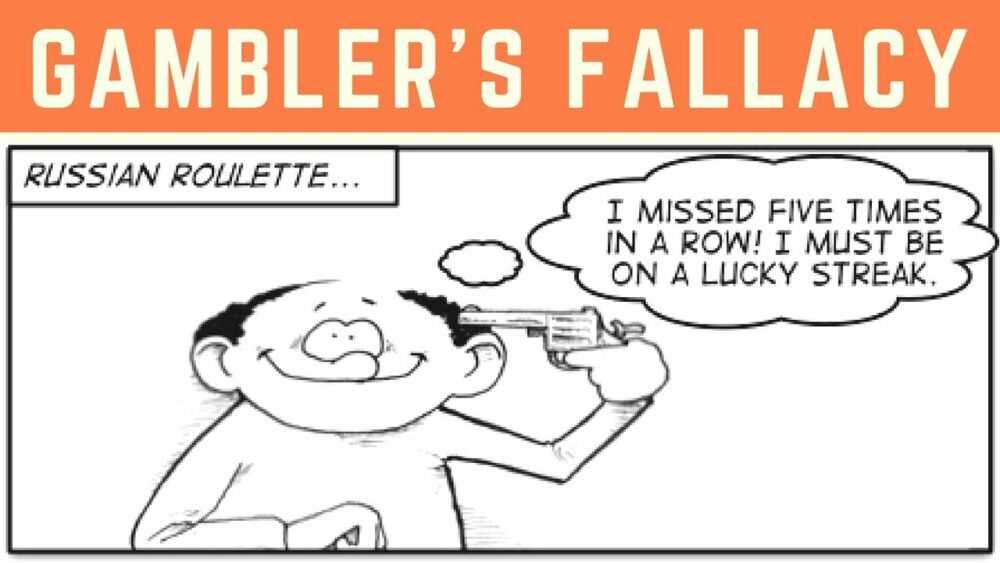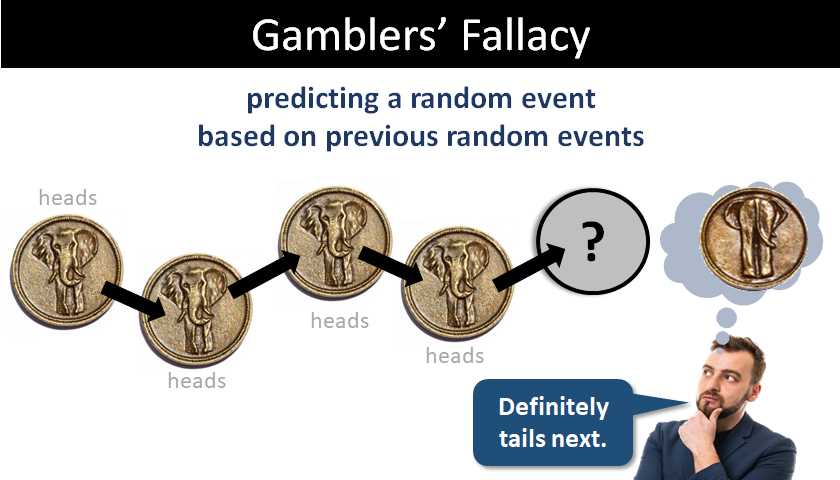The Gambler’s Fallacy Explained
The gambler’s fallacy is a common cognitive bias that occurs when individuals believe that the outcome of a random event is influenced by previous outcomes, even though the events are statistically independent. This fallacy is based on the mistaken belief that past events can somehow predict future outcomes.
For example, imagine a person flipping a fair coin. If the coin lands on heads five times in a row, someone who falls victim to the gambler’s fallacy might believe that the next flip is more likely to land on tails, assuming that the previous outcomes have somehow influenced the future outcome. However, in reality, the probability of the coin landing on heads or tails remains 50% for each flip, regardless of the previous outcomes.
The gambler’s fallacy can also be observed in games of chance, such as roulette. If a roulette wheel lands on black for several consecutive spins, some players may start betting on red, assuming that the wheel is “due” for a red outcome. However, each spin of the wheel is an independent event, and the previous outcomes have no influence on the future outcomes.
This cognitive bias can lead individuals to make irrational decisions based on faulty reasoning. It can also contribute to the development of gambling addictions, as individuals may mistakenly believe that they can predict or control the outcome of random events.
Common Misconceptions about the Gambler’s Fallacy
The Gambler’s Fallacy is a cognitive bias that occurs when individuals believe that the outcome of a random event is influenced by previous outcomes, even though the events are statistically independent. This fallacy is commonly observed in gambling situations, where individuals mistakenly believe that the outcome of a game of chance is more likely to occur or not occur based on previous outcomes.
Misconception 1: The Hot Hand Fallacy
One common misconception about the Gambler’s Fallacy is the belief in the “hot hand.” Many people think that if a player has been winning or experiencing a winning streak, they are more likely to continue winning. This misconception is based on the belief that there is a pattern or trend in the outcomes, when in reality, each outcome is independent of the previous one.
For example, in a game of roulette, if the ball has landed on black for the past five spins, some individuals may believe that red is more likely to come up on the next spin. However, the probability of the ball landing on red or black is always the same on each spin, regardless of previous outcomes.
Misconception 2: The Law of Averages
Another common misconception is the belief in the “law of averages.” This misconception suggests that if a certain outcome has not occurred in a while, it is more likely to occur in the future to balance out the probabilities. However, this belief is not supported by statistical theory.
For example, in a game of coin toss, if the coin has landed on heads for the past ten tosses, some individuals may believe that tails is more likely to come up on the next toss. However, the probability of the coin landing on heads or tails is always 50%, regardless of previous outcomes.
Misconception 3: Predictability of Random Events

Many individuals also mistakenly believe that random events can be predicted based on patterns or trends. They may think that if a certain outcome has occurred frequently in the past, it is more likely to occur in the future. However, this misconception fails to account for the nature of randomness.
For example, in a game of poker, if a player has been dealt a good hand multiple times in a row, some individuals may believe that they are more likely to be dealt a good hand in the next round. However, the cards are shuffled randomly, and the probability of receiving a good hand is always the same on each round, regardless of previous outcomes.
The Role of Probability in the Gambler’s Fallacy
However, individuals who fall prey to the Gambler’s Fallacy mistakenly believe that the probability of a specific outcome changes based on previous outcomes. For instance, if a coin has landed on heads several times in a row, they may believe that the next toss is more likely to result in tails. This is a fallacy because each coin toss is an independent event with a fixed probability of 50% for heads and 50% for tails.
This misconception can also be observed in casino games such as roulette. If the ball has landed on black several times in a row, some players may believe that red is now more likely to occur. However, the probability of the ball landing on red or black remains the same for each spin, regardless of the previous outcomes.
Real-Life Examples of the Gambler’s Fallacy
The gambler’s fallacy is a common cognitive bias that can lead individuals to make irrational decisions based on faulty reasoning. It occurs when someone believes that the outcome of a random event is influenced by previous outcomes, even though the events are statistically independent. Here are some real-life examples that illustrate the gambler’s fallacy:
1. Coin Flipping
One classic example of the gambler’s fallacy is the belief that if a fair coin has landed on heads multiple times in a row, it is more likely to land on tails on the next flip. In reality, each coin flip is an independent event with a 50% chance of landing on either heads or tails, regardless of previous outcomes.
2. Lottery Numbers
Another common example is the belief that if certain lottery numbers haven’t been drawn in a while, they are due to be drawn soon. This misconception leads people to choose numbers that they believe are “overdue,” even though the probability of any specific number being drawn is the same for each draw.
3. Sports Betting
In sports betting, the gambler’s fallacy can lead individuals to make poor decisions. For example, if a basketball player has made several successful shots in a row, some spectators may believe that they are “on fire” and more likely to make their next shot. However, the player’s shooting percentage remains constant, and each shot is an independent event.
4. Stock Market
Investors may also fall victim to the gambler’s fallacy when trading stocks. If a stock has been performing well for a period of time, some investors may believe that it is more likely to continue its upward trend. However, stock prices are influenced by various factors and are not directly influenced by previous price movements.
5. Roulette
In roulette, players may believe that if a certain number or color has not appeared in a while, it is more likely to come up in the next spin. This misconception can lead to poor betting decisions, as each spin of the roulette wheel is an independent event with the same probability for each outcome.
Overcoming the Gambler’s Fallacy: Strategies for Rational Decision-Making

The Gambler’s Fallacy is a cognitive bias that leads individuals to believe that past events can influence the likelihood of future events, even when the events are independent and random. This fallacy can have significant implications for decision-making, as it can lead to poor choices and irrational behavior. However, there are strategies that individuals can employ to overcome the Gambler’s Fallacy and make more rational decisions.
Educate Yourself on Probability
Recognize the Gambler’s Fallacy in Action
Being aware of the Gambler’s Fallacy and recognizing when it is influencing your decision-making is crucial. By acknowledging the fallacy, you can take steps to counteract its effects. This may involve pausing and reassessing your assumptions or seeking input from others to gain a different perspective.
Use a Systematic Approach
Instead of relying on intuition or gut feelings, it can be helpful to use a systematic approach when making decisions. This involves gathering relevant information, analyzing the data objectively, and considering all possible outcomes. By taking a systematic approach, individuals can reduce the influence of the Gambler’s Fallacy and make more rational choices.
Set Clear Decision-Making Criteria
Setting clear decision-making criteria can help individuals avoid being swayed by the Gambler’s Fallacy. By establishing specific guidelines or rules for decision-making, individuals can focus on the relevant factors and avoid being influenced by irrelevant past events. This can lead to more rational and consistent decision-making.
Seek Feedback and Input
Seeking feedback and input from others can provide valuable insights and help counteract the influence of the Gambler’s Fallacy. By involving others in the decision-making process, individuals can gain different perspectives and challenge their own biases. This can lead to more well-rounded and rational decision-making.

Emily Bibb simplifies finance through bestselling books and articles, bridging complex concepts for everyday understanding. Engaging audiences via social media, she shares insights for financial success. Active in seminars and philanthropy, Bibb aims to create a more financially informed society, driven by her passion for empowering others.
